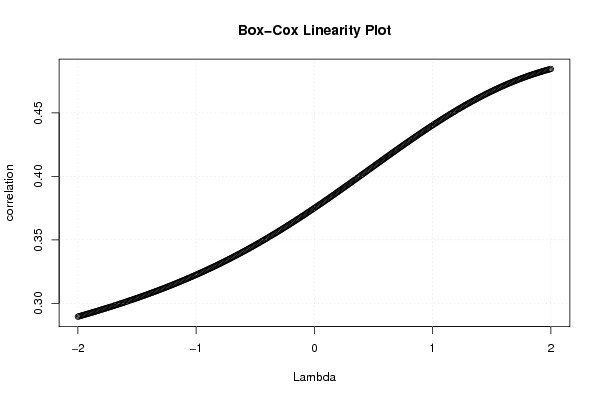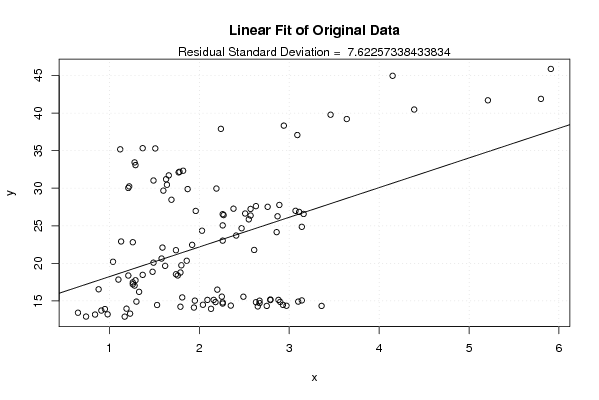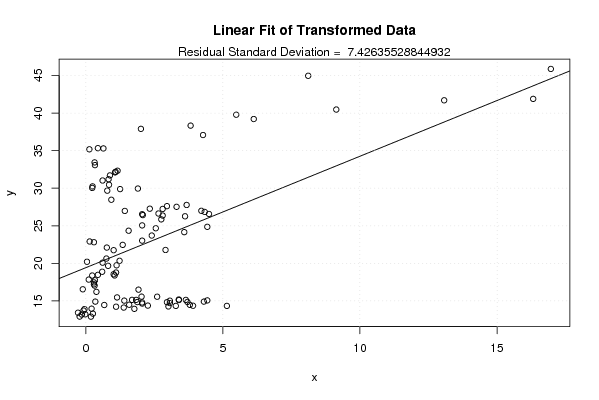Free Statistics
of Irreproducible Research!
Description of Statistical Computation | |||||||||||||||||||||||||||||||||||||||||||||
|---|---|---|---|---|---|---|---|---|---|---|---|---|---|---|---|---|---|---|---|---|---|---|---|---|---|---|---|---|---|---|---|---|---|---|---|---|---|---|---|---|---|---|---|---|---|
| Author's title | |||||||||||||||||||||||||||||||||||||||||||||
| Author | *The author of this computation has been verified* | ||||||||||||||||||||||||||||||||||||||||||||
| R Software Module | rwasp_boxcoxlin.wasp | ||||||||||||||||||||||||||||||||||||||||||||
| Title produced by software | Box-Cox Linearity Plot | ||||||||||||||||||||||||||||||||||||||||||||
| Date of computation | Tue, 11 Nov 2008 13:09:37 -0700 | ||||||||||||||||||||||||||||||||||||||||||||
| Cite this page as follows | Statistical Computations at FreeStatistics.org, Office for Research Development and Education, URL https://freestatistics.org/blog/index.php?v=date/2008/Nov/11/t1226434229cinkfc0nsv8us5e.htm/, Retrieved Sun, 19 May 2024 12:12:24 +0000 | ||||||||||||||||||||||||||||||||||||||||||||
| Statistical Computations at FreeStatistics.org, Office for Research Development and Education, URL https://freestatistics.org/blog/index.php?pk=23921, Retrieved Sun, 19 May 2024 12:12:24 +0000 | |||||||||||||||||||||||||||||||||||||||||||||
| QR Codes: | |||||||||||||||||||||||||||||||||||||||||||||
|
| |||||||||||||||||||||||||||||||||||||||||||||
| Original text written by user: | |||||||||||||||||||||||||||||||||||||||||||||
| IsPrivate? | No (this computation is public) | ||||||||||||||||||||||||||||||||||||||||||||
| User-defined keywords | |||||||||||||||||||||||||||||||||||||||||||||
| Estimated Impact | 112 | ||||||||||||||||||||||||||||||||||||||||||||
Tree of Dependent Computations | |||||||||||||||||||||||||||||||||||||||||||||
| Family? (F = Feedback message, R = changed R code, M = changed R Module, P = changed Parameters, D = changed Data) | |||||||||||||||||||||||||||||||||||||||||||||
| F [Box-Cox Linearity Plot] [Q3] [2008-11-11 20:09:37] [787873b6436f665b5b192a0bdb2e43c9] [Current] | |||||||||||||||||||||||||||||||||||||||||||||
| Feedback Forum | |||||||||||||||||||||||||||||||||||||||||||||
Post a new message | |||||||||||||||||||||||||||||||||||||||||||||
Dataset | |||||||||||||||||||||||||||||||||||||||||||||
| Dataseries X: | |||||||||||||||||||||||||||||||||||||||||||||
0,95 0,98 1,23 1,17 0,84 0,74 0,65 0,91 1,19 1,30 1,53 1,94 1,79 1,95 2,26 2,04 2,16 2,75 2,79 2,88 3,36 2,97 3,10 2,49 2,20 2,25 2,09 2,79 3,14 2,93 2,65 2,67 2,26 2,35 2,13 2,18 2,90 2,63 2,67 1,81 1,33 0,88 1,28 1,26 1,26 1,29 1,10 1,37 1.21 1.74 1.76 1.48 1.04 1.62 1.49 1.79 1.8 1.58 1.86 1.74 1.59 1.26 1.13 1.92 2.61 2.26 2.41 2.26 2.03 2.86 2.55 2.27 2.26 2.57 3.07 2.76 2.51 2.87 3.14 3.11 3.16 2.47 2.57 2.89 2.63 2.38 1.69 1.96 2.19 1.87 1.6 1.63 1.22 1.21 1.49 1.64 1.66 1.77 1.82 1.78 1.28 1.29 1.37 1.12 1.51 2.24 2.94 3.09 3,46 3,64 4,39 4,15 5,21 5,80 5,91 | |||||||||||||||||||||||||||||||||||||||||||||
| Dataseries Y: | |||||||||||||||||||||||||||||||||||||||||||||
13.92 13.22 13.31 12.91 13.19 12.92 13.43 13.72 13.97 14.91 14.46 14.12 14.23 15.04 14.80 14.49 15.14 14.34 15.12 15.14 14.34 14.36 14.91 15.56 16.50 15.57 15.14 15.19 15.07 14.48 14.27 14.72 14.65 14.38 13.95 14.85 14.87 14.83 15.03 15.47 16.21 16.55 17.04 17.22 17.47 17.75 17.84 18.47 18.38 18.55 18.39 18.88 20.21 19.67 20.09 18.78 19.74 20.64 20.34 21.75 22.10 22.81 22.91 22.46 21.78 25.05 23.70 23.02 24.34 24.15 25.85 26.42 26.54 26.36 26.99 27.52 26.63 26.26 24.86 26.84 26.57 24.67 27.24 27.77 27.61 27.27 28.46 26.97 29.95 29.88 29.67 31.19 30.24 30.03 31.02 30.45 31.70 32.10 32.32 32.18 33.43 33.07 35.32 35.17 35.29 37.89 38.32 37.07 39.77 39.20 40.46 44.95 41.69 41.88 45.86 | |||||||||||||||||||||||||||||||||||||||||||||
Tables (Output of Computation) | |||||||||||||||||||||||||||||||||||||||||||||
| |||||||||||||||||||||||||||||||||||||||||||||
Figures (Output of Computation) | |||||||||||||||||||||||||||||||||||||||||||||
Input Parameters & R Code | |||||||||||||||||||||||||||||||||||||||||||||
| Parameters (Session): | |||||||||||||||||||||||||||||||||||||||||||||
| Parameters (R input): | |||||||||||||||||||||||||||||||||||||||||||||
| R code (references can be found in the software module): | |||||||||||||||||||||||||||||||||||||||||||||
n <- length(x) | |||||||||||||||||||||||||||||||||||||||||||||

















